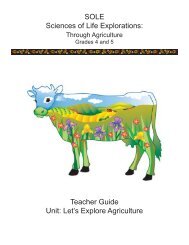Diseases of Corn - New York State Integrated Pest Management ...
Diseases of Corn - New York State Integrated Pest Management ...
Diseases of Corn - New York State Integrated Pest Management ...
You also want an ePaper? Increase the reach of your titles
YUMPU automatically turns print PDFs into web optimized ePapers that Google loves.
<strong>Corn</strong> diseases in NYSinclude:Pythium Damping OffRhizoctonia Damping OffAnthracnose Leaf BlightEye SpotGray Leaf SpotYellow Leaf BlightNorthern Leaf BlightSouthern Leaf BlightNorthern Leaf SpotAnthracnose Stalk RotCommon RustCommon SmutGibberella Stalk RotFusarium Stalk Rot<strong>Corn</strong> diseases aren’t always easy to identify—yetmay reduce grain and silage yields and quality.Accurate disease identification is crucial inselecting resistant hybrids.Consult the IPM Field <strong>Corn</strong> PocketGuide, p. 71 to 93, for guidance incorn disease identification.Different diseases may have similarsymptoms—if in doubt, consult theCCE diagnostic lab.Principles <strong>of</strong> SamplingScout for corn diseases while monitoring for otherpests and overall crop condition.AnalysisThere are no thresholds for corn diseases in <strong>New</strong><strong>York</strong>. If you find clear symptoms, identify theproblem. <strong>Management</strong> options may be limited forthis year’s crop, but correct ID will lead the way toproper management in next year’s crop. Followrecommendations in the Pocket Guide.<strong>Management</strong> AlternativesSound crop management the key to managing corndisease. Healthy, vigorous plants have less chance <strong>of</strong>being infected.Cropping sequenceContaminated crop debris may harbor many types <strong>of</strong>diseases. Moldboard plowing may prove helpful inreducing disease severity.Southern, northern, and yellow leaf blights, eyespot, grayleaf spot, and anthracnose are debris-borne diseases thatcan build up in continous corn or low-and no-till culture.Selection <strong>of</strong> planting siteTo manage seed rots and seedling blights, avoid plantingin cool, wet, or poorly drained soils.To manage leaf diseases, avoid planting corn in low-lying,shaded fields with poor air circulation and high relativehumidity.Seedbed preparationThoroughly incorporate previous crop debris—especiallyin fields <strong>of</strong> continuous corn and in fields where you’vepreviously had serious disease problems.Manage stalk rot, common smut, and leaf blights (amongothers) by correcting soil pH (to 6.0 or above) andfertilizing according to soil test results. Optimize cropgrowth and development. Balanced fertility is key: avoidtoo-high N and too-low K.Date <strong>of</strong> plantingGrain that is thoroughly mature at harvest is least likely tobecome moldy—so plant early unless soils are too coldand wet.Plant populationDense stands can increase risk <strong>of</strong> stalk rot, particularlyunder high-N conditions. Reduce plant populationsin fields with a history <strong>of</strong> stalk rot.Follow current plant population recommendations(<strong>Corn</strong>ell Guide for<strong>Integrated</strong> Field Crop <strong>Management</strong>).Hybrid maturityEarly maturing hybrids and timely harvest alleviateear rots associated with immature grain and earlyfrost—provided they are harvested promptly aftermaturity and not allowed to stand until late fall.Seed TreatmentsFungicide seed treatments control seed decay,seedling blight, and dampening <strong>of</strong>f.Disease-Resistant Hybrids• Several hybrids are generally resistant to some corndiseases—but none are resistant to all.• Review your records to double-check which diseaseshave been prevalent in your fields.• Even a moderate level <strong>of</strong> resistance is enough toprevent losses to certain diseases.• “Tolerance” is the ability to produce acceptableyields although the plant shows symptoms.• Strong stalk rind characteristics may be as importantas, or more important than resistance to internalstalk-rotting organisms. Select hybirds with goodstandability.• Leaf blights can be devastating if they develop duringor before the first four weeks after pollination.• Most resistance in corn is based on a single gene. Ifa fungus develops a new race the corn can becomesusceptible again. Breeders are working on multiplegene resistance to improve hybrid resistance.
ImplementationSeed TreatmentsMost purchased seed is pre-treated with afungicide to protect it while in storage. To protectfrom insect and disease problems after planting,use a planter box treatment with a recommendedinsecticide / fungicide. Here’s how:• Fill half the planter box with seed.• Add half the amount <strong>of</strong> chemical required for theentire planter box.• Stir thoroughly with a stick—not your bare hands.• Fill the planter box with seed.• Add the remaining half <strong>of</strong> chemical.• Stir again thoroughly.• Read and follow the fungicide label and wearprotective clothing.ReevaluationEvaluate after crop emergence for signs <strong>of</strong>disease, insect problesms, or other early seasonproblems.Monitor for mid-season foliar diseases and otherpest problems.Following pollination, monitor for stalk rot andlodging. Early harvest may minimize losses ifsignificant problems exist.Review your crop plan for the previous andcoming year to ascertain potential problem fields.For pesticide recommendations please consult the currentissue <strong>of</strong> <strong>Corn</strong>ell Guide for <strong>Integrated</strong> Field Crop <strong>Management</strong>.Always remember to read and follow the pesticide label.For additional help contact your local <strong>Corn</strong>ell CooperativeExtension Educator.<strong>Corn</strong>ell Cooperative Extension provides equalprogram and employment opportunities.<strong>New</strong> <strong>York</strong> <strong>State</strong><strong>Integrated</strong> <strong>Pest</strong> <strong>Management</strong> (IPM) ProgramWe encourage people to adopt a sustainable approach to managing pests,combining methods that minimize economic, health, and environmentalrisks.The IPM strategy integrates the use <strong>of</strong> several pest-suppression technologies,including• Biological control: beneficial organisms, such as insect predators• Cultural techniques: practices such as crop rotation, sanitation• Mechanical and physical methods: screens, traps, cultivation, and temperaturemodification• Chemical control. judicious use <strong>of</strong> pesticides and other chemicals• Genetic control. traditional selective breeding and new biotechnologypractices that produce pest-resistant varieties• Regulatory control. state and federal regulations that prevent the spread <strong>of</strong>pest organisms.The <strong>New</strong> <strong>York</strong> <strong>State</strong> IPM Program funds projects to improve IPM strategiesand <strong>of</strong>fers educational programs and resources.Many organizations and individuals assist in this effort. <strong>Corn</strong>ell University,<strong>Corn</strong>ell Cooperative Extension, the <strong>New</strong> <strong>York</strong> <strong>State</strong> Department <strong>of</strong> Agricultureand Markets, the <strong>New</strong> <strong>York</strong> <strong>State</strong> Department <strong>of</strong> Environmental Conservation,and USDA-CSREES jointly fund the NYS IPM Program.<strong>New</strong> <strong>York</strong> <strong>State</strong>Agricultural Experiment StationGeneva, NY 14456(800) 635-8356 FAX: (315) 787-2360http://www.nysipm.cornell.edu/<strong>Diseases</strong> <strong>of</strong> field corn in <strong>New</strong> <strong>York</strong>expected at various growth stagesDisease<strong>Diseases</strong>Pythium damping <strong>of</strong>fRhizoctonia damping <strong>of</strong>fAnthracnose Leaf BlightEye SpotGray Leaf SpotYellow Leaf BlightNorthern Leaf BlightSouthern Leaf BlightNorthern Leaf SpotAnthracnose Stalk RotCommon RustCommon SmutGibberella Stalk RotFusarium Stalk RotApri/ MayXXXXJ une July /AugustXXXXXXXXX<strong>of</strong><strong>Corn</strong><strong>Management</strong>GuideDid you know...XXXXXXXXXXXX
















